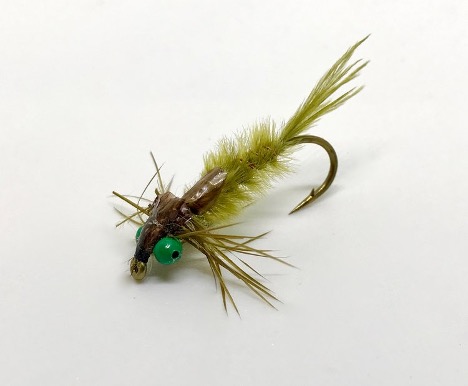The fly pattern chosen for the next Beginner’s tying session will be the Green Eyed Damsel nymph.
Damselflies are present spring through fall each year. As such, different species of damselflies will emerge at different times of the year. Some appear sporadically, while others emerge in mass with vast numbers of insects migrating towards shore at the same time. If you are on the water during one of these emergences, the fishing can be incredible if you have a passable nymph imitation.
The Green Eyed Damsel nymph pattern incorporates several new materials which can be used in the tying of other nymph and streamer fly patterns.
This pattern (ref. internet, “Panfish on the Fly, the Green Eyed Damselfly Nymph”) calls attention to the use of green bead chain eyes on the fly which more realistically imitates the eyes of the natural damselfly nymph. In addition, ostrich herl is used to represent both the body and tail of the fly. Ostrich herl seemingly provides a better imitation of the gills present on the live insect, rather than dubbing which is commonly used in tying large nymphs. The fly also features emu feathers which represent the legs of the damselfly.
Step-by-Step Instructions / Materials

Materials:
- TMC 2308 or equivalent stonefly hook size 6 or 8
- Thread- 6/0 olive
- Eyes- metal bead chain eyes colored green
- Underbody- 15-20 wraps lead or lead substitute
- Tail- olive ostrich feather fibers (~5-6)
- Rib – fine copper wire
- Body – olive ostrich herl
- Shellback/wing buds – brown medallion sheeting
- Legs – olive emu feather
- Thorax- olive dubbing
Tying Steps:
- Insert hook in vise after pinching down the hook barb.
- Begin wrapping lead/lead substitute wire approximately mid shank and wrap forward 15-20 wraps stopping ~1/4” behind the hook eye.
- Begin thread wraps immediately behind the rear portion of the lead wraps to secure it from sliding to the rear of the hook, proceed forward over the lead wraps and then immediately in front of the lead wraps creating a tapered block of thread both at the front and rear of the lead wraps.
- The thread should now be at the front of the hook. At this point tie in a pair of chain eyes on the underside of the hook directly in front of the lead wraps. Secure the eyes with a series of X thread wraps and circle wraps. Consider putting a drop of quick-dry cement (e.g. Zap-a-Gap) on the thread wraps to secure the eyes.
- Wrap thread to the rear stopping above the hook barb. At this location Tie in ~5-6 ostrich feather fibers, such that the tips of these fibers are ~hook shank length (but no longer). Secure with several thread wraps then wrap thread ~1/4 forward and clip off the butts of the fibers.
- Take a piece of copper wire ~2 ½” long and tie in along the far side of the hook immediately behind the lead wire (long end of the wire will then be extended beyond the rear of the hook). Thread wraps to the rear over the wire stopping at the same location where the tail was tied in.
- Tie in several (2-3) ostrich herl fibers with the tying thread, and secure them by the tips at the location where the thread was hanging from the previous step.
- Hold the herl fibers out of the way and wrap the thread forward until it lies just behind the chain eyes. Following this wrap the herl fibers around the hook shank and forward until it comes to where the thread is hanging. Secure the herl fibers at this location with several thread wraps and clip off the excess herl.
- Palmer wrap the wire forward through the ostrich herl and secure with thread wraps at the location where the herl was tied off. Clip off excess wire.
- Then take section of medallion sheet approximately 1 ½” long X1/4” wide and cut one end to a point.
- Lay the section of the medallion sheet along the top of the hook such that the pointed end is toward the rear of the hook, point at mid shank. Secure the medallion sheet with several thread wraps and lay the loose (blunt) blunt end slightly back.
- Just forward of where the medallion sheet is tied in secure a single emu feather, by the feather butt with the tip of the feather pointing to the rear of the hook.
- Dub the thread and make wraps with the dubbed thread forward to the bead chain eyes, followed by making several wraps of the emu feather over the dubbing. (These emu wraps represent the fly legs). Secure the emu feather at immediately behind the bead chain eyes, and clip off excess feather.
- Advance thread forward in front of the fly stopping immediately behind the hook eye.
- Then pull the medallion sheet forward over the emu and bead chain eyes. Secure the shell back (medallion sheet) immediately in front of the bead chain eyes. Hold the medallion sheet up and wrap thread forward stopping behind the hook eye.
- Cut the remaining piece of medallion sheet off in a point and secure with several thread wraps. Cut thread, trim the emu to represent legs extending below the fly abdomen.
—Don Fine



You must be logged in to post a comment.